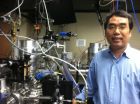Radiation from early universe found key to answer major questions in physics
2014-05-13
(Press-News.org) Astrophysicists at UC San Diego have measured the minute gravitational distortions in polarized radiation from the early universe and discovered that these ancient microwaves can provide an important cosmological test of Einstein's theory of general relativity. These measurements have the potential to narrow down the estimates for the mass of ghostly subatomic particles known as neutrinos.
The radiation could even provide physicists with clues to another outstanding problem about our universe: how the invisible "dark matter" and "dark energy," which has been undetectable through modern telescopes, may be distributed throughout the universe.
The scientists are publishing details of their achievement in the June issue of the journal Physical Review Letters, the most prestigious journal in physics, which highlighted their paper as an "editor's suggestion" because of its importance and significance to the discipline.
The UC San Diego scientists measured variations in the polarization of microwaves emanating from the Cosmic Microwave Background—or CMB—of the early universe. Like polarized light (which vibrates in one direction and is produced by the scattering of visible light off the surface of the ocean, for example), the polarized "B-mode" microwaves the scientists discovered were produced when CMB radiation from the early universe scattered off electrons 380,000 years after the Big Bang, when the cosmos cooled enough to allow protons and electrons to combine into atoms.
Astronomers had hoped the unique B-mode polarization signature from the early cosmos would allow them to effective "see" portions of the universe that are invisible to optical telescopes as gravity from denser portions of the universe tug on the polarized light, slightly deflecting its passage through the cosmos during its 13.8 billion year trip to Earth. Through a process called "weak gravitational lensing," the distortions in the B-mode polarization pattern, they hoped, would allow astronomers to map regions of the universe filled with invisible "dark matter" and "dark energy" and well as provide a test for general relativity on cosmological scales.
The recent discovery confirms both hunches. By measuring the CMB polarization data provided by POLARBEAR, a collaboration of astronomers working on a telescope in the high-altitude desert of northern Chile designed specifically to detect "B-mode" polarization, the UC San Diego astrophysicists discovered weak gravitational lensing in their data that, they conclude, permit astronomers to make detailed maps of the structure of the universe, constrain estimates of neutrino mass and provide a firm test for general relativity.
"This is the first time we've made these kinds of measurements using CMB polarization data," said Chang Feng, the lead author of the paper and a physics graduate student at UC San Diego who conducted his study with Brian Keating, an associate professor of physics at the university and a co-leader of the POLARBEAR experiment. "This was the first direct measurement of CMB polarization lensing. And the amazing thing is that the amount of lensing that we found through these calculations is consistent with what Einstein's general relativity theory predicted. So we now have a way to verify general relativity on cosmological scales."
The POLARBEAR experiment examined a small (30 degree square) region of the sky to produce high resolution maps of B-mode polarization, which enabled the team to determine that the amplitude of gravitational fluctuations they measured was consistent with the leading theoretical model of the universe, known as the Lambda Cold Dark Matter cosmological model. Another team Keating's group collaborates with, based at the Harvard-Smithsonian Center for Astrophysics, called BICEP2, used a telescope at the South Pole to examine B-mode polarization across wide swaths of the sky. In March, it announced it had found evidence for a brief and very rapid expansion of the early universe, called inflation.
One of the most important questions in physics that can be addressed from these data is the mass of the weakly interacting neutrino, which was thought to have no mass, but current limits indicate that neutrinos have masses below 1.5 electron volts. Feng said the B-mode polarization data in his study, while consistent with the predictions of general relativity, are not statistically significant enough yet to make any firm claims about neutrino masses. But over the next year, he and Keating hope to analyze enough data from POLARBEAR, and its successor instrument — the Simons Array— to provide more certainty about the masses of neutrinos.
"This study is a first step toward using polarization lensing as a probe to measure the mass of neutrinos, using the whole universe as a laboratory," Feng said.
"Eventually we will be able to put enough neutrinos on a 'scale' to weigh them—precisely measuring their mass," Keating says. "Using the tools Chang has developed, it's only a matter of time before we can weigh the neutrino, the only fundamental elementary particle whose mass is unknown. That would be an astounding achievement for astronomy, cosmology and physics itself."
INFORMATION:
The study was supported by grants from the National Science Foundation, National Aeronautics and Space Administration, the Simmons Foundation, and Irwin and Joan Jacobs.
ELSE PRESS RELEASES FROM THIS DATE:
Smart drugs pose special risks to the developing brain of young people
2014-05-13
Over a million American students misuse prescription drugs or take illegal stimulants to increase their attention span, memory, and capacity to stay awake. Such "smart drugs" become more and more popular due to peer pressure, stricter academic requirements, and the tight job market. But young people who misuse them risk long-term impairments to brain function, warn Kimberly Urban at the University of Delaware and Wen-Jun Gao at Drexel University College of Medicine, USA, in a NIH-funded review published in the open-access journal Frontiers in Systems Neuroscience.
The ...
The physics of ocean undertow
2014-05-13
WASHINGTON D.C. May 13, 2014 -- People standing on a beach often feel the water tugging the sand away from under their feet. This is the undertow, the current that pulls water back into the ocean after a wave breaks on the beach.
Large storms produce strong undertows that can strip beaches of sand. By predicting how undertows interact with shorelines, researchers can build sand dunes and engineer other soft solutions to create more robust and sustainable beaches.
"Formulation of the Undertow Using Linear Wave Theory," a new paper in the journal Physics of Fluids, clears ...
MEMS nanoinjector for genetic modification of cells
2014-05-13
WASHINGTON D.C. May 13, 2014 -- The ability to transfer a gene or DNA sequence from one animal into the genome of another plays a critical role in a wide range of medical research—including cancer, Alzheimer's disease, and diabetes.
But the traditional method of transferring genetic material into a new cell, called "microinjection," has a serious downside. It involves using a small glass pipette to pump a solution containing DNA into the nucleus of an egg cell, but the extra fluid can cause the cell to swell and destroy it—resulting in a 25 to 40 percent cell death rate.
Now, ...
Why athletes are more likely to need pacemakers in old age
2014-05-13
A new study by The University of Manchester has shed light on why athletes are more likely to have abnormal heart rhythms.
Elderly athletes with a lifelong history of training and competing in endurance events like marathons, triathlons and iron man challenges can have heart rhythm disturbances, known as arrhythmias.
The Manchester research in rodents, funded by the British Heart Foundation, shows molecular changes in the heart's pacemaker occur in response to exercise training.
The finding, reported in Nature Communications, overturns the commonly held belief that ...
Study: state VAMS don't reflect content, quality of teachers' instruction
2014-05-13
WASHINGTON, D.C., May 13, 2014—New research published online today in Educational Evaluation and Policy Analysis (EEPA), a peer-reviewed journal of the American Educational Research Association, finds weak to nonexistent relationships between state-administered value-added model (VAM) measures of teacher performance and the content or quality of teachers' instruction. Based on their results, the authors question whether VAM data will be useful in evaluating teacher performance and shaping classroom instruction.
VIDEO: Co-author Morgan S. Polikoff discusses key findings ...
Ultrafast laser technique developed to observe electron action
2014-05-13
University of Central Florida physicist Zenghu Chang has done it again. For a third time this year, his research group has published an article in a Nature journal.
This time, Chang and his team have developed a new ultrafast light source for observing electron motion in molecules – made up of nuclei and electrons – at the point before the nuclei start to move. By being able to observe what actually happens, scientists can begin to understand how an electron interacts with other electrons, which may help improve the efficiency of solar cells.
"The charge migration that ...
Released prisoners are more likely to suffer early death
2014-05-13
Men who have been incarcerated and released are more than twice as likely to die prematurely as those who have not been imprisoned, according to a new study published by Georgia State University criminologist William Alex Pridemore.
Former prisoners are more likely to die early from infectious and respiratory diseases, drug overdoses and homicides. Causes of this "mortality penalty" include increased exposure to diseases like TB and HIV, the prolonged stress of the prison environment, the disruption of important social bonds and, upon release, the struggle to reintegrate ...
Forgiving a wrong may actually make it easier to forget
2014-05-13
We're often told to "forgive and forget" the wrongs that we suffer – it turns out that there may be some scientific truth behind the common saying. A study from researchers at the University of St. Andrews in Scotland shows that the details of a transgression are more susceptible to forgetting when that transgression has been forgiven.
The findings are published in Psychological Science, a journal of the Association for Psychological Science.
"It is well established that learning to forgive others can have positive benefits for an individual's physical and mental health," ...
Signal Fire in New Mexico
2014-05-13
Firefighters are currently battling the Signal Fire in the Gila National Forest in New Mexico. The fire was reported by the Signal Peak Lookout Tower Sunday (May 11) in the afternoon and is located approximately 15 miles north of Silver City. It is currently estimated to be 4,700 acres. The Southwest Area Incident Management Team assumed command of the fire Monday at 6:00 p.m. The cause of the fire is thought to be human either a careless camper or arson, but the investigation is still ongoing. Residents in the vicinity of Signal Peak have evacuated. The firefighters ...
Screening is 'not effective' in the fight against domestic violence
2014-05-13
One in three women around the world have experienced physical or sexual violence from a partner. Although domestic violence is associated with a range of adverse health impacts, even after the abuse has ended, it is not easily identified by health care professionals, prompting some countries, notably the United States, to introduce screening programmes in healthcare settings. A new study, published online by the BMJ today [13 May], has found no evidence to support domestic violence screening.
Researchers from the Universities of Bristol and Melbourne, La Trobe and Columbia ...



